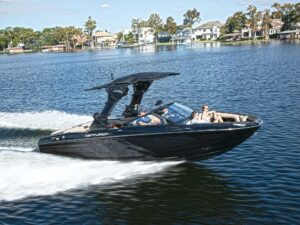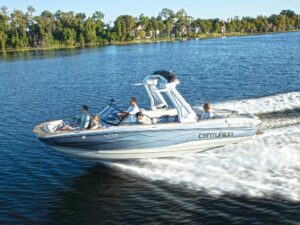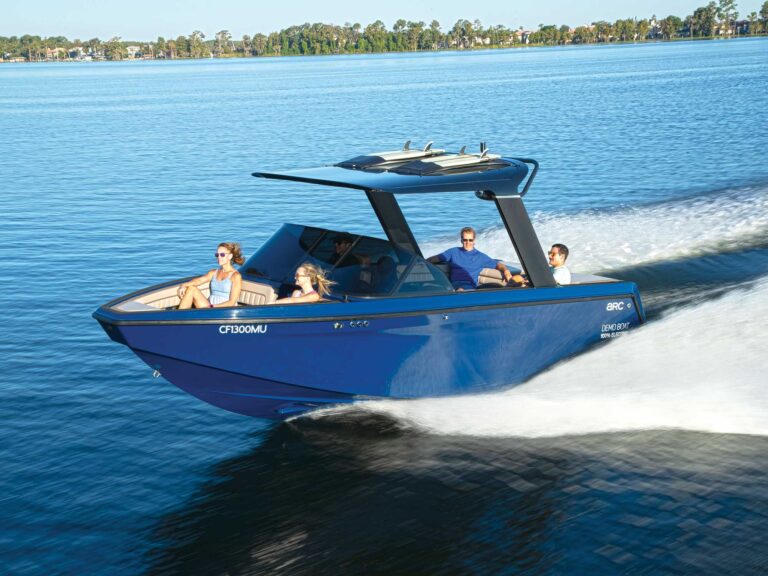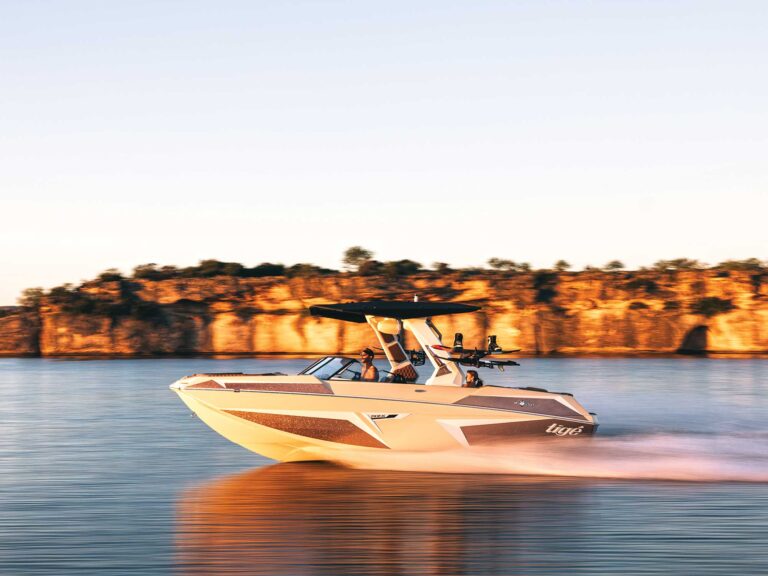
Surface preparation is the key to a bright shine, and electric buffers are the best way to remove oxidation, stains, and fine scratches for a lasting result. It’s 90 percent of the work, and without doing it, today’s new synthetic polymers and newer silicone dioxide compounds called ceramic can actually magnify surface imperfections and accelerate oxidation. And the trending graphene—a blend of silicone dioxide and a molecular derivative of carbon—will tint an improperly prepared surface an appalling gray.
So we tested several electric buffers to make the easiest time of prep work, and spoke to some experts on their equipment recommendations, techniques and accessories to get a professional finish, save time, and make sure boaters spend more time boating and less time buffing.
How We Tested
The equipment and accessories we’ve tested here are ideal for surface preparation for ceramic, graphene, polymer-wax and carnauba-wax protective coatings. We applied an X-shaped or a circular bead of multistage compound to the pad. Either shape worked fine as long as we pressed the pad against the hull before pulling the trigger to avoid “slinging” the compound. We worked in 2-foot-square patches, polishing in a crosshatch motion. GTecniq and Shurhold experts advised us to buff no more than 45 seconds to avoid generating damaging heat.
Note: High-speed rotary buffers are designed for aggressive compounding, known as cutting, and are best reserved for experienced detailers. Dual-action orbital buffers are ideal for casual weekend warriors. We tested only the Hercules 12-volt rotary buffer, and thanks to its smaller wheels, it’s ideal for detail work in confined areas.
Buffers

Worx 20-Volt Cordless Orbital Buffer
$99.99; worx.com
We’ve tested many Worx tools, and they’ve all been nicely matched to their tasks. This new 10-inch orbital buffer is another good example. If you’ve got a supply of Worx tools, you have plenty of batteries to extend the 40-minute run time of the single included battery, and you can keep one on the charger while buffing. A thick 10-inch foam backer pad accepts the included applicator pad and the included synthetic-wool polishing pad. The orbital action at 3,000 rpm ensures that the polishing action won’t cause swirls. Its steering-wheel-style grip gives plenty of handling options, and at 6.8 pounds, it’s easy to manage.
Our Test: We liked the large pad for covering hullsides. The rotation stops if the pad is overpressured, but the back-and-forth orbital motion continues. The maximum 3,000 rpm speed is ideal for light compounding, and excellent for finish polishing.
Included: Polishing bonnet, compounding bonnet, battery, charger
- Power: 20 V cordless
- Speeds: 3,000 rpm
- Pads: 10-inch bonnets
- Weight: 6.3 lb.

Hercules HD035B 12-Volt CORDLess Variable-Speed Polisher/Sander
$69.99 tool; Batteries $24.99 2 ah, $34.99 4 ah; $44.99 charger; harborfreight.com
This buffer uses backing plates with threaded spindles and runs 3-inch buffer pads from 3 to 6 inches, making it ideal for a smaller boat or smaller surface areas such as helm stations and multifaceted interior spaces. The direct-drive rotary spindle has high- and low-speed settings for protecting delicate finishes or aggressively removing oxidation. Batteries and charger are a la carte.
Our Test: Its light weight makes it easy to control, and its small pads proved handy on our helm station, giving easier access and control. Variable speeds at zero to 2,800 rpm are ideal for polishing; high speeds of zero to 8,300 rpm are best for sanding.
Included: 1 3/4-inch and 2 3/4-inch sanding plates, 2 7/8-inch hook-and-loop buffing-pad backer, 2 foam pads, 1 wool buff pad, ambidextrous screw in right-angle handle
- Power: 12 V cordless
- Speeds: Low 0 to 2,800; high 0 to 8,300 rpm
- Pads: 3- to 6-inch wheels
- Weight: 1.6 lb.

Shurhold Dual-Action Polisher
179.98; shurhold.com
This six-speed polisher is designed exclusively for Shurhold, a nationally acclaimed manufacturer of boat-care products. Each speed activates a faster rpm, from 2,500 to 6,500. Its random orbital action ensures a smooth, deep finish when properly used. Load up the wool or foam pad with a circular bead of polish, then press it to the surface before activating the polisher. High speed is for final polishing; use slower speeds for heavier compounds and cutting. The handle rotates from vertical to horizontal at the polishing head and gives a balanced grip.
Our Test: The handle proved easy to adjust for a comfortable angle, but we preferred the horizontal position for an even application of force. Setting the speed is easy with the thumb dial at the cord end of the buffer. A larger hand can better manage the grip at the trigger, but finger grooves on the bottom and the rubber padded top enhance control and add comfort to the large handle. We like the easy one-thumb trigger-lock mechanism for continuous running.
Included: Deluxe canvas storage bag, quick-change Velcro backing plate, pad wrench, standard side handle, deluxe D handle, pair of replacement carbon brushes, 20-foot power cord, GFCI plug adapter.
- Power: 120 V 4.5 amp
- Speeds: 6 speed; 2,500 to 6,500 rpm
- Pads: 5- to 6-inch hook-and-loop
- Weight: 4.8 lb.
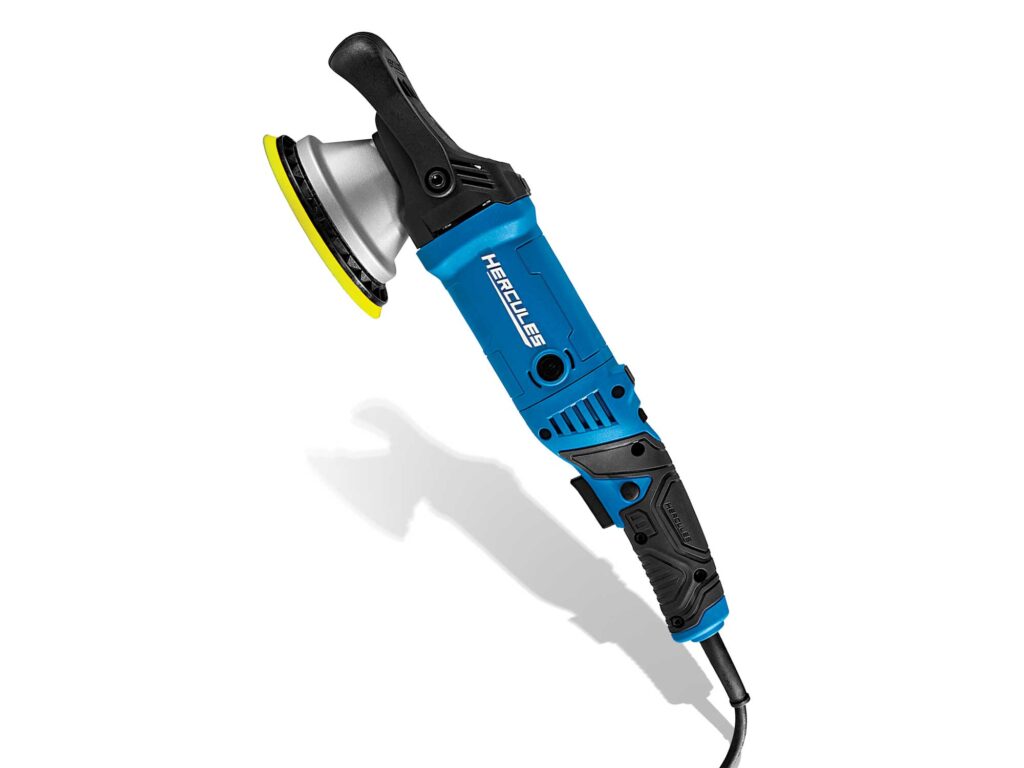
Hercules HC109B 8-Amp 6-inch Forced Rotation Dual-Action Polisher
$129.99; harborfreight.com
This is the most aggressive rotary polisher we’ve seen that’s also equipped with the random orbital rotation for preventing swirling and burning. While many orbital or dual-action polishers’ pads will stall out if too much pressure is applied, this one continues to spin and orbit, giving more control—and more need for care—when removing heavy damage to a finish.
Our Test: We liked the tapered grip of the tool and its trigger position right away. The front D-shaped handle is designed to be used in the horizontal position to evenly apply the pad flat against the surface to avoid overheating the finish. For that reason, we agreed with the fixed-handle design. Its soft start trigger is engaged on every rpm setting, and the speed-adjustment dial offers infinite options. Use lower speeds for polishing to avoid risk of swirling. Reserve the higher speeds for rapid removal of material in sanding.
Included: 6-inch hook-and-loop pad, 25-foot cord, 8-millimeter hex wrench
- Power: 120 V
- Speeds: Variable 3,200 to 9,600 rpm
- Pad: 6-inch hook-and-loop
- Weight: 6.3 lb.

Meguiar’s MT300 DA
$240.80 buffer only; amazon.com
We weren’t able to test the soft-start trigger’s ability to stop compound slinging, but the feature should ensure optimal control. Dual-action orbiting helps prevent swirling, and the 3,000 to 6,500 rpm variable speed is controlled by a handy thumbwheel. The D-shaped handle rotates fore and aft, from 90 degrees vertical to horizontal in front of the wheel. The two-handed grip should reduce fatigue.
- Included: Buffer only
- Power: 120 V; 4.5 amp
- Speeds: Variable 3,000 to 6,500 rpm
- Pads: 5-inch hook-and-loop
- Weight: 5.4 lb.

Another Option: Dual-action Power-System Tool
$70.99; meguiarsdirect.com
Attach this to any variable-speed drill for easy buffing. We think that it would be ideal for the diligent DIY guy with one boat who keeps up finish maintenance and doesn’t require extensive surface restoration. It is far faster and more useful than hand-polishing but not as effective as a dedicated buffer. Dual-action orbital motion helps prevent swirls.
Read Next: Use Boat Paint, Never Wax Your Boat Again
Polishing Compounds

GTecniq Multistage Polish
This polish is one of two multistage compounding systems. It starts out aggressively at 1500-grit, and as it is worked against the surface, the grit breaks down to 2500-grit. Quit buffing before it dries, and wipe off the residue with a microfiber towel. Inspect and repeat if necessary. We tried it on metal surfaces and found it to work well there too. A 17-ounce bottle should buff a 25-foot boat. $37.95 (17 oz.); gtechniq.com

Shurhold BUFF Magic
This is also a multistage compound that begins as an aggressive formula with a tougher grit, then the grit breaks down into finer and finer particles as it is polished in. Eventually, it results in a high-gloss finish after removing oxidation and fine scratches. Buff Magic is also an excellent metal-polishing compound, but mask the area around it to protect from black metal residue. Shurhold says that 22 ounces finishes a 25-foot boat. $37.55 (22 oz.); shurhold.com
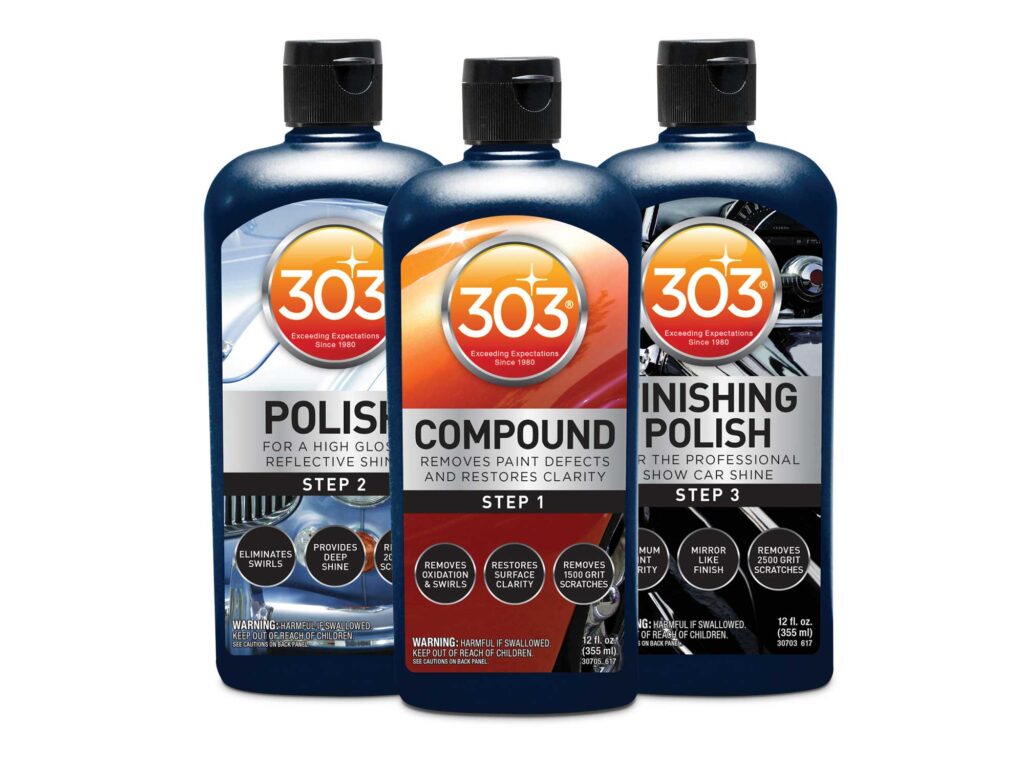
303 Three-Step Finishing Polish
The 303 system comes in three bottles: Step 1 is 1500-grit for cutting; Step 2 is 2000-grit for leveling; Step 3 is 2500-grit for final prep and polish. This system worked well, and applying each compound successively for 45 seconds did the job with minimal effort. For each 12-ounce bottle: Step 1 $21.80, Step 2 $35.18, Step 3 $24.99; amazon.com
Bonnets and Pads

Wool Pads
Wool pads are generally synthetic today, and per GTechniq’s experts, that’s OK. Each pad should be cleaned by running it over with a brush or a spur between applied sections. This removes caked-on compound and impurities from the finish. Wool is generally the choice of expert detailers. Hook-and-loop backing is the preferred attachment on 3- to 6-inch pads. Lace-on bonnets are usually used on 10-inch orbital buffers.
Foam Pads
These are used on buffer wheels less than 8 inches in diameter. They come in various consistencies from fine to coarse grit. They are less durable, disposable and, in our experience, require more care to avoid swirling. Buy several for a 25-foot boat.
Note: Whether you use wool or foam pads is a question of experimentation. Each hull is different, and our experts suggest trying a test area before proceeding to the entire hull.



